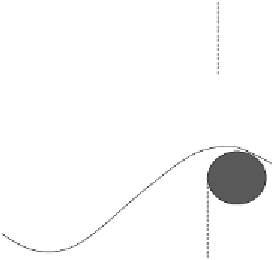Image Processing Reference
In-Depth Information
Figure 7.9
Grayscale morphology.
A commonly used shape of structuring element is a sphere or ball. Dilation and ero-
sion operations may be effected by allowing the ball to roll over or under the sur-
face and plotting the locus of the center of the ball. Similarly, openings and closings
may be found by recording the places swept out by the surface of the ball as it rolls
under or over the surface, respectively. Figure 7.9 shows an example of a spherical
structuring element beneath the surface of a grayscale image. Such filters are effec-
tive at removing isolated noise spikes in grayscale images.
Grayscale morphology certainly represents a more general type of processing
than stack filters. However, erosions and dilations by single structuring elements
rarely achieve acceptable results. The simple design method for binary and stack
filters does not readily generalize to grayscale filters. Design of grayscale structur-
ing elements has so far only been achieved through iterative processes such as ge-
netic algorithms.
6
Grayscale morphology uses the same structuring elements at every level. There
is therefore one further stage of generalization which allows the implementation of
any type of filter, linear or nonlinear. This has been formalized by Dougherty as the
concept of computational morphology.
7,8,9
It is an overall framework based on
thresholding, and a brief introduction is given below.
7.3 Computational Morphology for Beginners
Since all digital imaging processes may be programmed or implemented in hard-
ware, it is therefore possible to filter grayscale images by forming logical functions
of all of the bits of the input. However, for a 3 × 3 filter with 8-bit data, this would
result in a function of 72 bits. (Actually it would be 8 functions of 72 bits, one func-
tion for each of the output bits.)





